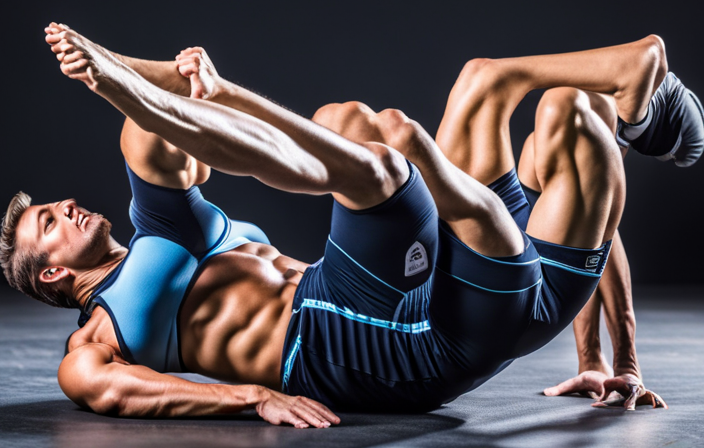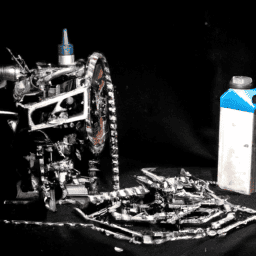Imagine yourself on a bicycle, riding through a picturesque setting. Now, envision replicating that movement on the ground, with your legs elevated. This is the concept behind bicycle crunches, a challenging workout that engages various muscles in your core.
In this article, I will explore the specific muscles that bicycle crunches work, highlighting the importance of each one. By understanding these muscle groups, you can maximize the effectiveness of this exercise and achieve a stronger, more stable core.
Key Takeaways
- Quadriceps, hip abductors, and calf muscles contribute to lower body stability during bicycle crunches.
- Shoulder muscles support proper posture and upper body engagement.
- Biceps, triceps, and forearm muscles are engaged for stability and control.
- Bicycle crunches target multiple muscle groups for overall core stability and balance.
The Core Muscles Engaged in Bicycle Crunches
When you do bicycle crunches, you engage your core muscles, which are vital for stability and movement. The core muscles involved in bicycle crunches include the rectus abdominis, obliques, and transverse abdominis. These muscles work together to stabilize the spine, maintain proper posture, and facilitate rotational movements.
Additionally, bicycle crunches require controlled breathing, which further engages the core muscles and improves overall respiratory function. By incorporating bicycle crunches into your workout routine, you can strengthen and tone your abdominal muscles, improve core stability, and enhance athletic performance. Furthermore, these exercises can help increase calorie burn and promote weight loss.
Moving on to the next section, let’s discuss the role of the hip flexors in bicycle crunches.
The Role of the Hip Flexors
The hip flexors play a crucial role in bicycle crunches. These muscles, which include the iliopsoas and rectus femoris, are located in the front of the hip and are responsible for flexing the hip joint. During bicycle crunches, the hip flexors are actively engaged as they work to bring the knees towards the chest while the upper body rotates to touch the opposite elbow.
Strong hip flexors are essential for performing bicycle crunches effectively and efficiently. Additionally, having good hip flexor flexibility allows for a greater range of motion during the exercise, which can lead to increased muscle activation and better overall results. Strengthening the hip flexors can also help to improve posture and reduce the risk of lower back pain.
Transitioning to the subsequent section about strengthening the lower back muscles, it is important to focus on exercises that target this area as well.
Strengthening the Lower Back Muscles
Strengthening the lower back can help improve posture and reduce the risk of lower back pain. One effective exercise for targeting the lower back muscles is the bicycle crunch. While this exercise primarily focuses on the abdominal muscles, it also engages and strengthens the muscles in the lower back. This is because during the bicycle crunch, the lower back muscles work to stabilize the spine and maintain proper alignment. By incorporating bicycle crunches into your workout routine, you can not only strengthen your abdominal muscles but also develop a stronger and more stable lower back. This can lead to improved posture and a reduced risk of lower back pain. Next, let’s transition into the subsequent section about engaging the gluteal muscles.
Engaging the Gluteal Muscles
To engage your gluteal muscles, try incorporating exercises like squats or lunges into your workout routine. These exercises target the gluteus maximus, the largest muscle in your buttocks, and help strengthen it.
In addition to squats and lunges, you can also try exercises like side-lying leg lifts or lateral band walks. These exercises engage the gluteus medius, a smaller muscle on the outer side of your buttocks.
Engaging these muscles is important for overall lower body strength and stability. By incorporating these exercises into your routine, you can improve your posture, enhance your athletic performance, and reduce the risk of injuries.
In the next section, we will discuss the activation of the hamstrings and how it complements the engagement of the gluteal muscles.
Activation of the Hamstrings
When it comes to activating the hamstrings, three key muscles are involved: the biceps femoris, semitendinosus, and semimembranosus.
These muscles work together to flex the knee and extend the hip, playing an important role in movements like running, jumping, and squatting.
Understanding how these muscles function and how to engage them properly can help improve lower body strength and prevent injuries.
Biceps Femoris
The biceps femoris muscle is targeted during bicycle crunches. This muscle is one of the three muscles that make up the hamstring group, along with the semitendinosus and semimembranosus. Strengthening the hamstring muscles is essential for overall lower body strength and stability. The biceps femoris plays a crucial role in hip extension and knee flexion, which are both important movements during cycling and other lower body exercises. By engaging the biceps femoris during bicycle crunches, you not only work your abdominal muscles but also improve the strength and flexibility of your hamstrings. This can lead to better athletic performance, reduced risk of injury, and improved posture. Moving on to the next topic, let’s discuss the role of the semitendinosus muscle in bicycle crunches.
Semitendinosus
The semitendinosus muscle is also part of the hamstring group and is engaged during bicycle crunches. This muscle runs along the back of the thigh and plays a crucial role in knee flexion and hip extension.
When performing bicycle crunches, the semitendinosus contracts to stabilize the lower body and assist in the movement. Strengthening the hamstrings, including the semitendinosus, through exercises like bicycle crunches can help improve overall lower body strength and stability.
Additionally, this exercise can also contribute to enhancing hamstring flexibility. The combination of strength and flexibility in the hamstrings is essential for optimal performance in activities such as running, jumping, and squatting.
Now, let’s move on to the next muscle in the hamstring group, the semimembranosus.
Semimembranosus
To engage the semimembranosus, focus on exercises that target the back of your thigh. Strengthening your hamstrings can be achieved through a variety of hamstring exercises. Here are five effective exercises to consider:
- Romanian Deadlifts: This exercise primarily targets the hamstrings and helps improve their strength and flexibility.
- Glute Bridges: While this exercise mainly targets the glutes, it also activates the hamstrings to assist in hip extension.
- Hamstring Curls: Whether using a machine or resistance bands, hamstring curls isolate and strengthen the hamstrings.
- Good Mornings: This exercise targets the entire posterior chain, including the hamstrings, lower back, and glutes.
- Swiss Ball Leg Curls: By performing leg curls on a stability ball, you engage your hamstrings while also challenging your core stability.
By incorporating these hamstring exercises into your routine, you can effectively strengthen the semimembranosus and other muscles in the back of your thigh.
Moving on to the involvement of the quadriceps…
Involvement of the Quadriceps
Feel your quadriceps engaging as you perform bicycle crunches. The quadriceps, a group of four muscles located on the front of your thigh, play a crucial role in this exercise.
As you pedal your legs in a cycling motion, the quadriceps contract to extend your knee joint and bring your legs towards your chest. This activation of the quadriceps not only helps in the movement but also provides several benefits.
Firstly, it strengthens and tones the quadriceps, improving their overall strength and endurance. Secondly, it increases calorie burn, as the quadriceps are one of the largest muscles in the body and require significant energy to work. Lastly, by engaging the quadriceps, bicycle crunches help in supporting the lower body stability, contributing to a more effective and efficient workout.
Supporting the Lower Body Stability
Engaging your quadriceps during bicycle crunches helps support stability in your lower body. By activating these muscles, you not only work on leg strength but also improve posture and prevent lower back pain.
Here’s how the quadriceps contribute to supporting lower body stability during bicycle crunches:
-
Stability: The quadriceps play a crucial role in stabilizing your knees and hips, which are essential for maintaining proper form during the exercise.
-
Balance: Strong quadriceps help maintain balance and control while performing bicycle crunches, reducing the risk of injury.
-
Core engagement: When your quadriceps are activated, they work with your core muscles to provide stability and control throughout the movement.
Engaging your quadriceps is just the first step in a comprehensive workout routine. Next, we will focus on strengthening the hip abductors to further enhance lower body stability.
Strengthening the Hip Abductors
Strengthening the hip abductors can improve your lower body stability during bicycle crunches.
The hip abductors, which include the gluteus medius and gluteus minimus, are responsible for moving the legs away from the midline of the body. By targeting and strengthening these muscles, you can enhance your ability to keep your legs stable and prevent them from moving side to side during the exercise.
Additionally, bicycle crunches also activate the hamstrings, which are located at the back of the thighs. These muscles play a crucial role in stabilizing the knee joint and helping with hip extension.
By engaging and strengthening both the hip abductors and hamstrings, you can create a solid foundation for performing bicycle crunches effectively and with proper form. This stability will then allow for the activation of the shoulder muscles in the subsequent section.
Activation of the Shoulder Muscles
To activate your shoulder muscles during bicycle crunches, focus on maintaining proper posture and engaging your upper body. Shoulder mobility and stability are crucial for executing this exercise effectively.
As you perform the bicycle crunches, keep your shoulders relaxed and avoid shrugging them up towards your ears. Instead, actively retract and depress your shoulder blades, creating a stable base for movement. This will engage muscles such as the deltoids, rotator cuff, and trapezius.
Additionally, keep your elbows wide and your chest open to maximize shoulder mobility. By incorporating these techniques, you can enhance the activation of your shoulder muscles during bicycle crunches, promoting better overall upper body strength and stability.
This prepares you for the subsequent section about supporting the neck and upper back, ensuring a well-rounded workout.
Supporting the Neck and Upper Back
Make sure you maintain proper form and support your neck and upper back while performing bicycle crunches. This is crucial to prevent injuries and maximize the benefits of the exercise.
Supporting your neck and upper back during bicycle crunches helps to improve posture and reduces strain on these areas. Here are two important things to keep in mind:
- Use your hands to gently cradle the back of your head, providing support and preventing excessive strain on your neck.
- Engage your core muscles and keep your upper back lifted off the ground throughout the exercise, avoiding any rounding or slouching.
By supporting your neck and upper back, you not only protect these areas from potential injuries but also enhance the effectiveness of bicycle crunches in strengthening your abdominal muscles and improving your overall posture.
Moving forward, let’s explore the role of the biceps and triceps in this exercise.
The Role of the Biceps and Triceps
Support your biceps and triceps by maintaining a strong grip on the bicycle crunch handles. The biceps and triceps play an important role in bicycle crunches as they are responsible for flexing and extending the arm. Strengthening these arm muscles not only enhances the overall stability and control during the exercise but also contributes to the effectiveness of the workout.
Here is a visual representation of the muscles involved in bicycle crunches:
| Muscle | Role |
|---|---|
| Biceps | Flexes the arm |
| Triceps | Extends the arm |
By engaging the biceps and triceps, you can effectively target your arm muscles while performing bicycle crunches. This helps in building strength and definition in your arms. As we move on to the next section about engaging the forearm muscles, it is important to remember that a strong grip and proper form are crucial for maximizing the benefits of bicycle crunches.
Engaging the Forearm Muscles
Engaging the forearm muscles is essential for maintaining a strong grip during bicycle crunches. Strengthening the forearm muscles not only helps to prevent slipping and maintain stability, but it also enhances overall upper body strength and endurance.
When performing bicycle crunches, the forearm muscles, including the flexor and extensor muscles, are activated as they work to maintain a firm grip on the handlebars or the ground. This engagement not only supports the core muscles but also contributes to improved upper body coordination and control.
Strong forearms are crucial for various daily activities, such as lifting objects, carrying groceries, or even typing on a keyboard. Therefore, it is important to focus on forearm engagement during bicycle crunches to develop and strengthen these muscles.
Transitioning to the subsequent section, developing grip strength is key for maximizing the benefits of bicycle crunches.
The Importance of Grip Strength
Improving your grip strength is vital for maximizing the benefits of bicycle crunches. While bicycle crunches primarily target the abdominal muscles, engaging the forearm muscles is also crucial during this exercise.
By strengthening your grip, you enhance your ability to hold onto the handlebars or grips of the bicycle, increasing stability and control. This not only improves your performance during the exercise but also prevents any strain or injury to the wrists and forearms.
To enhance your grip strength, incorporate specific exercises such as wrist curls, farmer’s walks, and dead hangs into your workout routine. These exercises not only strengthen the forearm muscles but also have numerous other benefits, including improved hand dexterity, increased wrist stability, and reduced risk of developing conditions like carpal tunnel syndrome.
Strengthening the calf muscles is the next step in maximizing the benefits of bicycle crunches.
Strengthening the Calf Muscles
When it comes to grip strength, we often overlook the importance of strengthening our calf muscles. However, focusing on this muscle group can have significant benefits for overall strength and stability.
Bicycle crunches, a popular exercise, not only target the abdominal muscles but also engage the calf muscles. By flexing and extending the ankles during this exercise, the calf muscles are activated, which helps to strengthen the Achilles tendon and improve ankle stability.
This can be particularly beneficial for cyclists, as strong calf muscles and a stable ankle joint contribute to better pedaling efficiency and reduced risk of injury. So, in addition to working your abs, bicycle crunches provide an excellent opportunity to strengthen your calf muscles and improve overall lower body strength.
Now, let’s explore how bicycle crunches can contribute to improving overall core stability and balance.
Improving Overall Core Stability and Balance
To improve your overall core stability and balance, it’s important to focus on strengthening different muscle groups and incorporating various exercises into your routine.
Bicycle crunches are an excellent choice as they target multiple muscle groups simultaneously. This exercise primarily works the rectus abdominis, which is the main muscle responsible for creating that coveted six-pack appearance. Additionally, bicycle crunches engage the obliques, the muscles on the sides of your abdomen, helping to improve posture and increase overall core strength.
Furthermore, this exercise also engages the hip flexors, which play a crucial role in maintaining balance and stability.
By regularly incorporating bicycle crunches into your workout routine, you can improve your core stability, enhance your balance, and even increase flexibility in your hips and lower back.
Frequently Asked Questions
Do bicycle crunches help with weight loss?
Yes, bicycle crunches can help with weight loss. While they primarily target the abdominal muscles, they also engage other muscle groups. When compared to other cardio exercises, bicycle crunches contribute to overall fitness by improving cardiovascular endurance and burning calories.
Can bicycle crunches help with improving posture?
Bicycle crunches can indeed help improve posture by strengthening the core muscles. They also aid in improving balance and increasing flexibility, making them a beneficial exercise for overall postural alignment and stability.
Are bicycle crunches effective for building abdominal muscles?
Bicycle crunches are effective for building abdominal muscles. However, there are alternative exercises like planks and Russian twists. Additionally, a balanced diet is crucial for maximizing the effectiveness of bicycle crunches for abs development.
Can bicycle crunches be modified for individuals with lower back pain?
I can modify bicycle crunches for people with lower back pain. Instead, try exercises like plank variations, bird-dog, or pelvic tilts. These alternatives engage the core without putting excessive strain on the lower back.
How often should bicycle crunches be performed for optimal results?
For optimal results, I recommend performing bicycle crunches 2-3 times a week. It’s important to maintain proper form to prevent injury and engage the targeted muscles effectively. To increase intensity, you can try adding weights or increasing the number of repetitions.
Conclusion
In conclusion, bicycle crunches are a highly effective exercise for targeting and strengthening various muscles in the body.
From engaging the core muscles to working the hip flexors, lower back muscles, gluteal muscles, hamstrings, forearm muscles, and calf muscles, this exercise provides a complete workout.
By incorporating bicycle crunches into your fitness routine, you can improve core stability, balance, and overall strength.
So, if you’re looking for a challenging and efficient exercise, give bicycle crunches a try and reap the benefits.









